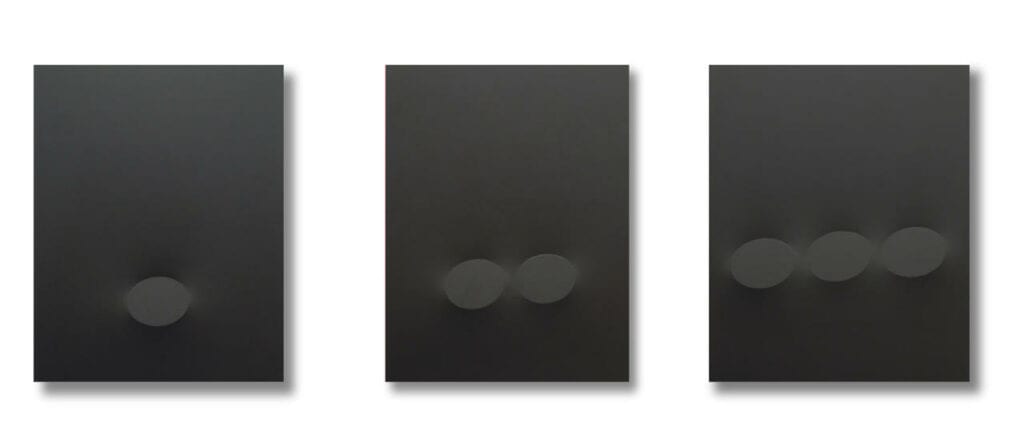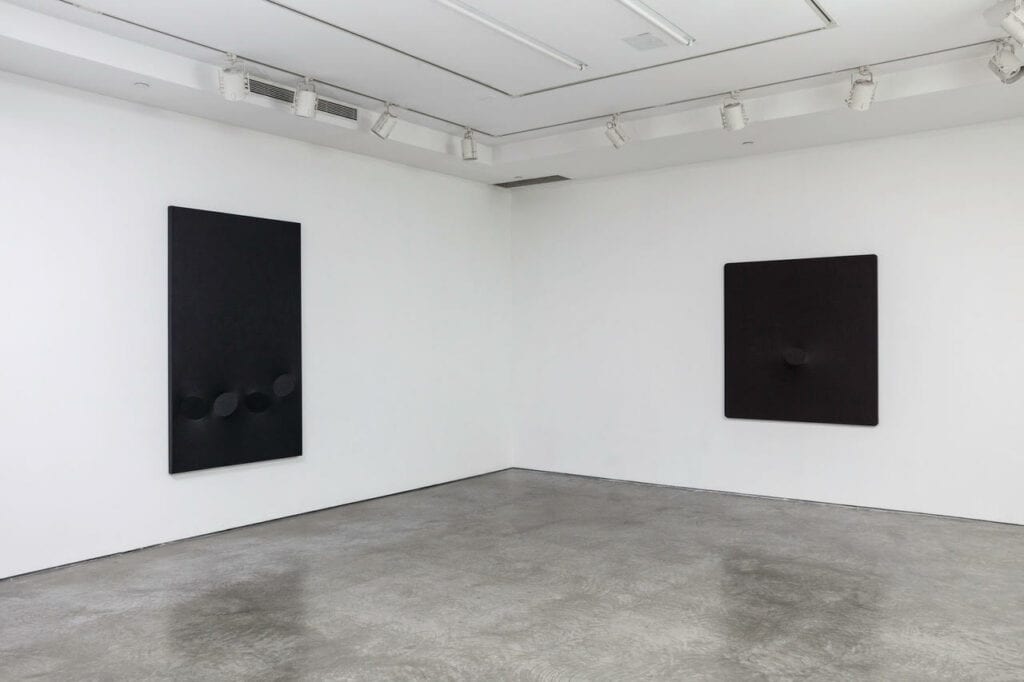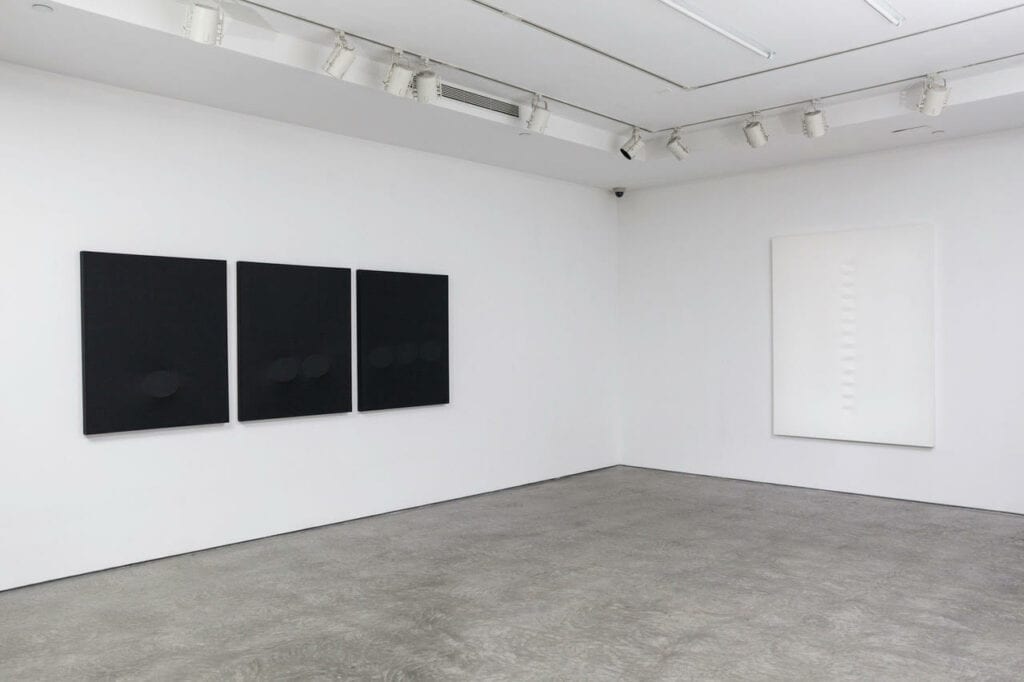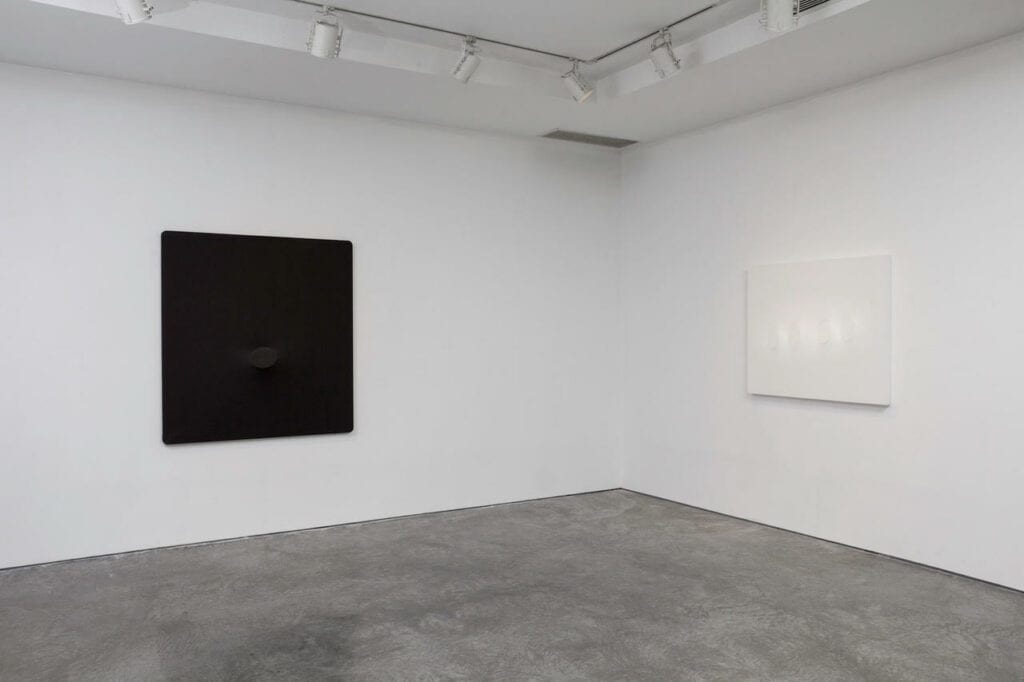by Elena Forin

In 1962, Turi Simeti (Alcamo,Trapani, 1929) created Tre ovali bianchi, the first work with what were to become the fundamental elements of his future artistic research: monochromy, the relationship between light and shade, and the presence of a shape – the oval – which is a hallmark of all his work.
Ever since then, these aspects have been at the heart of a reflection which, in a consistent, innovative manner, has given rise to a unique form of investigation.
I have observed that the canvas moves better if moved by an oval, than if by a circle. The oval exercises its depression gently, and proves somewhat asymmetric (…) the oval is gentle (…) it is a point of excitement of the surface, which acquires life and substance thanks to the light. Light is very important in my work, and so is shade.
Prior to 1962, which marked the shift to the mature period of his work, Simeti created collages of paper and mixed media. His point of reference in those years was [Alberto] Burri, whom he met in Rome after moving to the city from Alcamo in 1958. Burri’s influence is quite evident in his treatment of surfaces, in which burns and combustion were the devices he used to give voice to his initial visual language.
The oval began appearing in these initial works, and acquired concrete form in the act of burning, which rounded the edges of the papers and envelopes superimposed on his works. This period reveals more than one area of interest with regard to later developments, for while the burns were key to the creation of his visual vocabulary, also the use of collage played a fundamental role. The superimposition of materials led Simeti to a broader reflection, allowing him to experiment with the effect of these elements on the surface of the work and their relationship with it.

Starting out from this concept, the artist based his research on the constant construction and transformation of this relationship, which led him to abandon the burns and to arrange elliptical cardboard shapes on the surfaces of his canvases. As in his previous works, the ovals in this cycle are placed side by side, in regular geometrical structures. Shortly after, they underwent an even more radical change, turning into shapes that emerge from the back of the canvas, flexing it outwards and transforming it into a space of light and shade.
The Climate of Artistic Research in Italy
The artist’s linguistic and aesthetic development found fulfillment in the extremely vibrant world of Italian art in the 1960s, with its powerful drive towards experimentation, its constant interaction between artists and its exchanges with the liveliest research abroad.

This opening up, with its international input, had started in the previous decade as a result of exhibitions such as The New American Painting (1), which came to Italy from New York, and through organizations such as the Rome-New York Art Foundation (2). It was also encouraged by the work of Galleria La Tartaruga (3) in Rome, Galleria L’Ariete (4) in Milan, Galleria Notizie (5) in Turin, the arrival of Ileana Sonnabend (6) and Leo Castelli (7) and, from 1948, the presence in Venice of Peggy Guggenheim (8) and her professional association with another great name in the Italian art system, Carlo Cardazzo (9).
After the period of Informal Art, visual research embarked on a profound questioning of the languages and nature of works of art: there was a general reduction in visual grammar and a tendency to eliminate the material components of the work, in order to make way for a small number of elements, which could be analyzed to bring out their absolute value. Examples of this can be seen in the formal simplification brought about by the Gruppo Uno (10), in Agostino Bonalumi’s surface tensions, in the works of Piero Manzoni and Enrico Castellani, in Dadamaino’s volumes, in Paolo Scheggi’s “curved intersurfaces”, in kinetic experiments (11), and in the intersections of Azimuth (12) with the group Zero (13) which is being honored in 2014 by two of the most important contemporary art institutions (14).

In spite of their differences, in all of these cases it was considered to be “a matter of a convergence on a number of crucial nodes of theoretical reflection and operative experimentation: light, monochrome, space, hovering between science and the absolute, between innovative technologies and traditional materials and the subjectivity […] of the creator and the onlooker”. This was the setting for the extraordinary journey of Turi Simeti, who focused on “a reduction, a poetic of progressive decantation from the physical to the mental sphere, although the possibility to invert the process was never excluded”.
The oval as original form Monochromy offered the artist the greatest potential for testing form, its evolution in relation to light, and the rhythm that this relationship brought about. However, the choice of a single color also helped make the surface of the canvas an essential part of a process that sought total freedom of action. From this point of view, the change that occurred in his work in 1966 is significant, for at this point the ovals changed from “surface values” and became “original forms” of painting. They were now the heartbeat of painting beneath the canvas, which adopted them as absolute, pure icons.
New force fields are constantly created, partly as a result of the different angles that Simeti gives these elements, and on each occasion he experiments with the incidence of light, creating new relationships between the surface of the work and its surroundings.
The incessant interaction that the artist has brought about ever since has revealed the essential, continuous and inevitable exchange between the work and its environment. The work thus takes in every “event” that involves the canvas, absorbing its projections, returning its light and sinking deep into its shadows.
The expansion of such a profound, intimate field of action certainly owed much to the lesson of a great master, who had opened up spatiality to infinity: Lucio Fontana. His example, which was so crucial for generations of artists, not only inspired the development of an autonomous linguistic, visual and aesthetic universe, but also led to a further level of interaction with international artistic research: Fontana had in fact expressed his esteem for Simeti by inviting him to take part in Zero Avantgarde, 15 the legendary exhibition in his own studio, which brought together some of the most interesting and most up-to-date investigations of the time, from that of Yves Klein to those of Yayoi Kusama, Pol Bury, Jesús Rafael Soto and many others.
A Vision Forever in the Making
In his essay for the exhibition at the Galleria Cadario in Milan in 1968, Nello Ponente16 touched on a key aspect of the work of the Alcamo-born artist, which is that of the interaction between the work and its environment. This too proved to be fundamental for later artistic research. “The perception cannot be unidirectional, but in continuous progress, perforce varied depending on the points of view, changed by the possibility of walking around the object, by a perceptible detachment, by means of the support, from the wall surface, by artificial or natural lighting. Works environment? Perhaps, but in the sense that they do not undergo, but determine it.”
Whether they introduce a single oval (Un ovale nero, 1980) or more than one (Trittico nero con ovali in progressione 2011, 5 ovali neri 2010, or Tredici ovali bianchi 2013), Simeti’s art creates an intense involvement between work and space. In this exhibition, the interaction is made all the greater by the presence of works based only on the absolutes of darkness and light.
The movement of the ovals in the black and white further intensifies its own ability to transform the environment into a field of uncommon forces, which move, repel, attract and entice us from one form to another, from one rhythm to another, until we are drawn into a floating, joyously unstable dimension. So how does Simeti view the space of the work? It is certainly “not an immobile surface, a tabula rasa (…) but rather the stage of an action, or rather of a hypothesis to control, in short, the testimonial of an experimental condition of research which finds its temporary certainty in an alternation of negative and positive angles of incidence.”
Like an endless journey, through melodies, choirs, solo voices, contrasts and changes in frequency, this exhibition reveals the huge potential of the works to raise always new questions and to sow the seeds for the challenge to be confronted in the next work. This is indeed Simeti’s unique stylistic feature: an inexhaustible inquisitiveness which comes from a vision that is always in the making.
This essay first appeared in the catalogue, published in 2014 by De Buck Gallery, accompanying the show The Primary Form of Painting.

